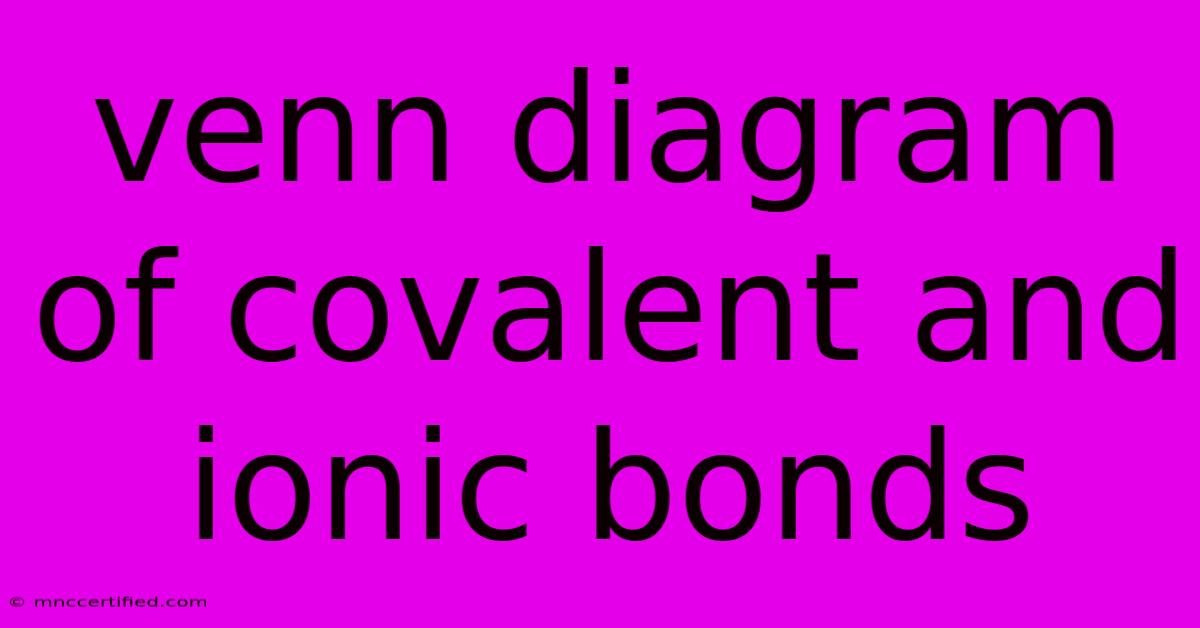Venn Diagram Of Covalent And Ionic Bonds

Table of Contents
Unveiling the Similarities and Differences: A Venn Diagram of Covalent and Ionic Bonds
The world of chemistry is built on the fundamental interactions between atoms. Two key players in this drama are covalent bonds and ionic bonds. While distinct in their nature, these bonds share some common ground, making it useful to visualize their relationships through a Venn diagram.
The Overlap: The Essence of Bonding
At the heart of the Venn diagram lies the shared characteristic: both covalent and ionic bonds involve the formation of chemical bonds between atoms. This means that both types of bonds result in the creation of stable, new entities called molecules or ionic compounds.
Here's why this overlap is crucial:
- Stability: Atoms strive for a stable electron configuration, often achieving it by sharing or transferring electrons. Both covalent and ionic bonds fulfill this desire.
- Energy Release: Forming bonds releases energy, contributing to the stability of the resulting compound.
The Distinct Zones: Delving into the Differences
Moving beyond the shared core, our Venn diagram reveals the unique characteristics of each bond type.
1. Covalent Bonds: Sharing is Caring
- Electron Sharing: In covalent bonds, atoms share electrons to achieve a stable electron configuration.
- Non-metal Partners: Covalent bonds typically form between non-metal atoms.
- Strong Bonds: Covalent bonds are generally strong and hold molecules together firmly.
- Examples: Water (H₂O), carbon dioxide (CO₂), methane (CH₄)
2. Ionic Bonds: The Transfer Game
- Electron Transfer: Ionic bonds involve the transfer of electrons from one atom to another, resulting in the formation of ions (charged particles).
- Metal and Non-metal Partners: Ionic bonds usually occur between metals and non-metals.
- Electrostatic Attraction: The opposite charges of the ions attract each other, holding the ionic compound together.
- Examples: Sodium chloride (NaCl), magnesium oxide (MgO), potassium bromide (KBr)
The Venn Diagram: A Visual Representation
Imagine a circle labelled Covalent Bonds and another labelled Ionic Bonds. The overlapping region in the middle represents the shared characteristic of forming chemical bonds.
- Inside the "Covalent Bonds" circle: You'll find the properties unique to covalent bonds, such as electron sharing and the formation of molecules.
- Inside the "Ionic Bonds" circle: You'll see the unique aspects of ionic bonds, such as electron transfer, ion formation, and electrostatic attraction.
- Inside the Overlap: The properties common to both, like achieving stability and energy release during bond formation.
Conclusion: Understanding the Nuances
The Venn diagram helps visualize the similarities and differences between covalent and ionic bonds. By understanding the individual characteristics and commonalities, you gain a deeper appreciation for the diverse ways atoms interact and form the building blocks of our world.

Thank you for visiting our website wich cover about Venn Diagram Of Covalent And Ionic Bonds. We hope the information provided has been useful to you. Feel free to contact us if you have any questions or need further assistance. See you next time and dont miss to bookmark.
Featured Posts
-
Official Bayern Munich Vs Benfica Lineups Announced
Nov 07, 2024
-
Carolina Casualty Insurance Company Claims
Nov 07, 2024
-
Estrella Roja Vs Barcelona Champions League Live
Nov 07, 2024
-
How Vance Silenced His Critics With Power
Nov 07, 2024
-
Walz Loses Home County To Trump In 2020
Nov 07, 2024